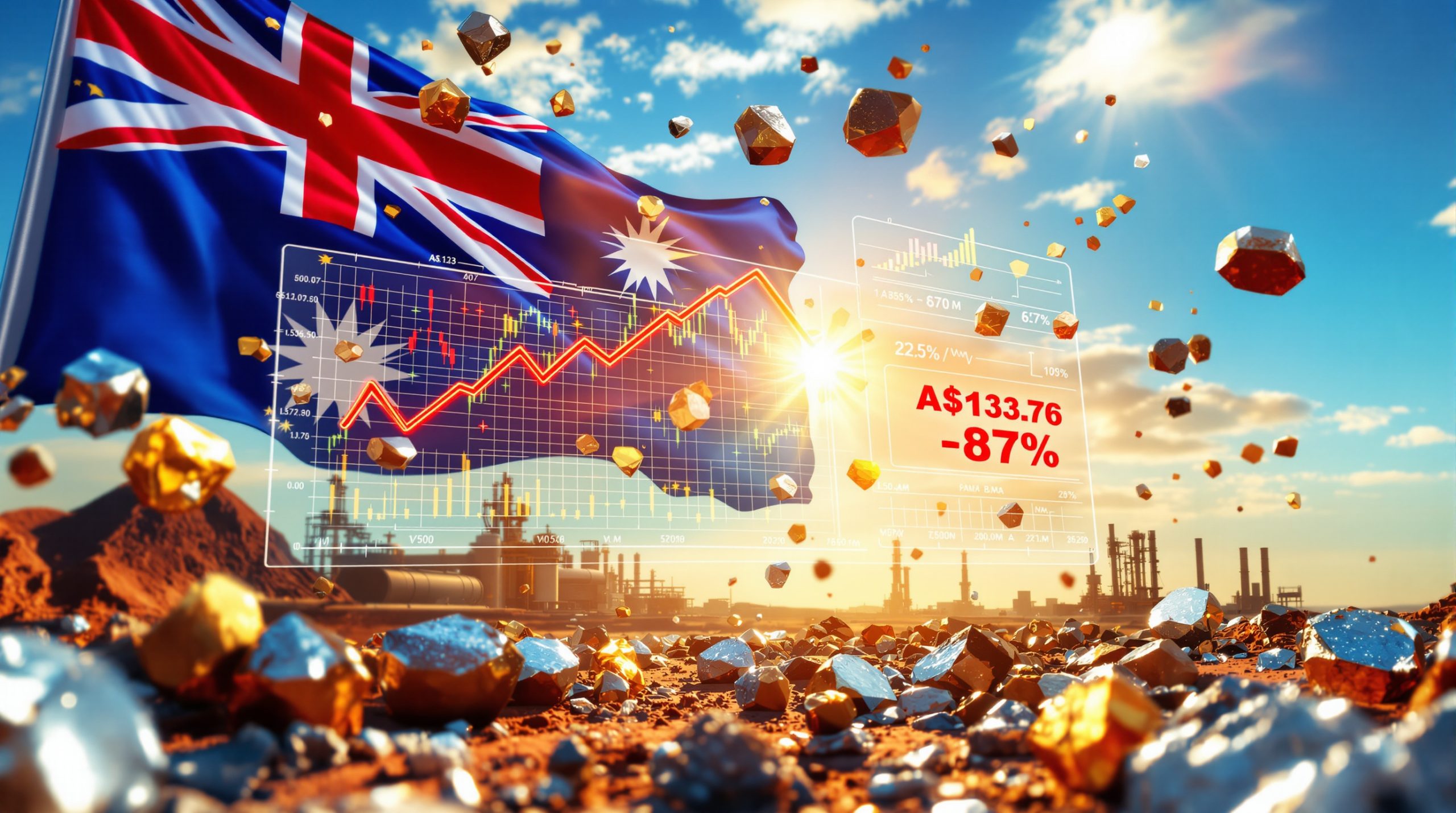Malaysia has positioned itself at the center of a transformative shift in Asia's rare earth value chain through its groundbreaking neodymium magnet plant rare earths Malaysia facility. This RM600 million (US$142 million) investment in Pahang state represents far more than another manufacturing plant – it signals Malaysia's evolution from raw material processor to high-value manufacturer in the critical minerals energy transition.
The facility emerges at a crucial juncture when global supply chain vulnerabilities have become starkly apparent. With China controlling approximately 85% of global rare earth magnet production, alternative manufacturing capabilities have become essential for Western manufacturers seeking supply security. Malaysia's strategic positioning, combined with substantial natural resources and international partnerships, creates a compelling foundation for this ambitious venture.
Breaking China's Manufacturing Monopoly in Rare Earth Magnets
The new facility addresses a fundamental weakness in global supply chains by establishing manufacturing capabilities beyond China's sphere of influence. Current market dynamics reveal the extent of this dependency: China processes not only the majority of global rare earth elements but also dominates the conversion of these materials into finished magnetic products essential for modern technology.
This concentration creates significant vulnerabilities for industries relying on rare earth magnets. Electric vehicle manufacturers, renewable energy companies, and defence contractors face potential supply disruptions that could halt production lines. The 2010 Chinese export restrictions on rare earth elements demonstrated the strategic leverage this concentration provides, prompting Western governments to prioritise supply chain diversification.
Key Supply Chain Benefits Include:
• Reduced dependency on single-source suppliers for critical magnetic materials
• Enhanced supply security for Western manufacturers through alternative sourcing
• Geographic diversification reducing transportation risks and delivery uncertainties
• Technology transfer opportunities between Australian, Korean, and Malaysian partners
• Competitive pricing through increased global production capacity
The timing proves particularly advantageous as global demand for rare earth magnets accelerates. Electric vehicle adoption, renewable energy deployment, and advanced electronics manufacturing all require increasing quantities of high-performance magnetic materials. Furthermore, the critical minerals supply crisis has highlighted the urgent need for alternative supply sources.
Malaysia's Resource Foundation and Processing Infrastructure
Malaysia's rare earth resource base provides substantial backing for downstream manufacturing activities. Government estimates indicate the country possesses approximately 16.1 million metric tons of rare earth deposits, ranking fourth globally in identified reserves. This represents roughly 13.4% of the world's known rare earth oxide reserve base.
However, Malaysia's approach differs significantly from traditional mining-focused strategies. The country has historically concentrated on processing rather than extraction, creating a unique position in the global value chain. The existing Lynas Advanced Materials plant in Kuantan already processes rare earth concentrates, providing essential infrastructure for the new magnet facility.
| Resource Category | Malaysia's Position | Strategic Advantage |
|---|---|---|
| Rare Earth Reserves | 16.1 million tonnes (4th globally) | Long-term supply security |
| Processing Infrastructure | Established via Lynas facility | Integrated value chain |
| Magnet Manufacturing | New capability (2025 launch) | Market entry opportunity |
| Technology Access | International partnerships | Accelerated capability development |
Prime Minister Anwar Ibrahim's direct involvement underscores the project's national significance. His statement that the investment is confirmed and land acquisition completed indicates government-level commitment to accelerated implementation. The designation of the trade minister to monitor project development reflects the strategic importance placed on rare earth sector advancement.
The partnership structure combines complementary strengths: Australian processing expertise through Lynas Rare Earths, South Korean manufacturing technology via JS Link, and Malaysian government support with resource access. This collaboration model addresses Malaysia's acknowledged technology gap while leveraging existing infrastructure investments. In addition, this approach aligns with broader mining industry evolution trends toward strategic partnerships.
Advanced Manufacturing Technologies and Production Processes
The facility will specialise in neodymium-iron-boron (NdFeB) permanent magnet production, utilising sophisticated sintering and bonding technologies. These manufacturing processes require precise control over material composition, temperature profiles, and magnetic field alignment to achieve high-performance specifications demanded by modern applications.
The manufacturing sequence involves five critical stages:
-
Raw Material Integration – Processed rare earth elements sourced from the adjacent Lynas facility undergo quality verification and composition analysis
-
Alloy Preparation – Neodymium, iron, and boron combine in precise stoichiometric ratios using high-temperature induction furnaces
-
Powder Metallurgy – Controlled milling creates fine magnetic powders with specific particle size distributions essential for sintering efficiency
-
Pressing and Sintering – Materials form under temperatures reaching 1050-1100°C with carefully managed pressure profiles
-
Machining and Coating – Final processing includes precision grinding and protective coating application to prevent corrosion
The facility's 3,000-tonne annual production capacity positions it to serve multiple market segments. Sintered magnets typically target high-performance applications requiring maximum energy density, while bonded magnets offer greater design flexibility for specialised applications. This production versatility enables the facility to adapt to evolving market demands across different industries.
Quality control throughout the manufacturing process proves critical for meeting international standards. Applications in electric vehicles, renewable energy systems, and consumer electronics require consistent magnetic properties and reliable performance under varying operational conditions. Moreover, the integration with existing critical raw materials facility concepts ensures comprehensive quality assurance.
Target Markets Driving Demand Growth
The facility targets three primary sectors experiencing unprecedented demand growth for rare earth magnets, each driven by fundamental technological and regulatory shifts.
Electric Vehicle Sector Expansion
Electric vehicle adoption creates substantial magnet demand, with each vehicle requiring 1-2 kilograms of rare earth magnets in motor applications. Permanent magnet synchronous motors (PMSM) dominate electric vehicle designs due to their superior efficiency and power density characteristics. Southeast Asia's growing electric vehicle market provides regional demand supporting local production economics.
Thailand, Vietnam, and Indonesia have announced significant electric vehicle development strategies. Malaysia's geographic position and magnet production capability enable integrated supply chain development serving regional automotive manufacturers. The proximity advantage reduces logistics costs and delivery lead times compared to Chinese suppliers.
Renewable Energy Infrastructure Requirements
Wind turbine generators represent one of the largest individual applications for rare earth magnets. Modern offshore wind turbines with 10+ MW capacity contain 400-600 kilograms of rare earth magnets in their permanent magnet generators. Direct-drive generator designs eliminate gearboxes but increase magnet content substantially.
Solar energy systems also require precision magnetic components in tracking mechanisms. Dual-axis solar trackers use magnetic positioning systems to optimise panel orientation throughout daily solar cycles. As renewable energy transformations accelerate across Southeast Asia, regional magnet supply becomes increasingly valuable.
Consumer Electronics Evolution
Consumer electronics applications continue expanding despite device miniaturisation trends. Average smartphones contain 3-5 rare earth magnets in speakers, vibration motors, and camera focus mechanisms. Global smartphone production exceeding 1.2 billion units annually creates substantial cumulative demand.
Audio equipment represents another significant application area. Premium speakers and headphones rely on high-performance magnetic driver systems delivering superior sound quality. As consumer preferences shift toward higher-quality audio experiences, magnet specifications become increasingly demanding.
"The convergence of electrification trends, renewable energy expansion, and electronics advancement creates a structural demand increase that cannot be met through efficiency improvements or material substitutions alone."
Economic Strategy and Government Support Framework
Prime Minister Anwar Ibrahim has positioned this initiative as a national priority, with direct ministerial oversight ensuring streamlined implementation and regulatory support. The project aligns with Malaysia's broader economic diversification strategy, moving beyond traditional commodity exports toward higher-value manufacturing activities.
Economic Development Objectives Include:
• Value Chain Advancement – Transitioning from raw material processing to finished product manufacturing
• Foreign Investment Attraction – Demonstrating Malaysia's capabilities to international technology partners
• Export Diversification – Creating new revenue streams from high-value magnetic products
• Technology Transfer Facilitation – Building domestic expertise through strategic partnerships
The government's approach emphasises technology acquisition through foreign direct investment rather than attempting independent development. This pragmatic strategy acknowledges Malaysia's current technological limitations while leveraging international partnerships to accelerate capability building.
Trade minister oversight of the project reflects government recognition that rare earth processing involves strategic considerations beyond typical manufacturing investments. The designation ensures policy coordination and regulatory support necessary for successful implementation.
Malaysia's balanced international engagement proves particularly valuable in this context. Recent agreements with the United States focus on critical minerals supply chain diversification, while ongoing discussions with China maintain access to existing markets and technologies. This non-confrontational positioning preserves economic relationships while developing alternative supply capabilities.
Geopolitical Implications and International Partnerships
Malaysia's magnet plant rare earths Malaysia project represents a significant development in global rare earth geopolitics, offering Western nations supply chain alternatives while maintaining strategic neutrality in great power competition. The facility's success could influence broader regional rare earth development and international supply chain configurations.
Strategic Partnership Frameworks
The United States signed cooperation agreements with Malaysia focusing on critical minerals supply chain diversification. These arrangements provide technology sharing opportunities and market access while avoiding exclusive partnership requirements. This approach enables Malaysia to maintain relationships with multiple international partners simultaneously.
China's response to Malaysian rare earth development remains constructive, with ongoing discussions regarding processing cooperation. Malaysia's balanced approach preserves access to Chinese markets and technology while developing independent capabilities. This positioning avoids confrontational dynamics that could complicate regional relationships.
Australia's involvement through Lynas Rare Earths provides established processing expertise and supply chain connections. The partnership leverages Australia's mining capabilities with Malaysia's strategic location and government support. South Korea's JS Link contributes advanced manufacturing technology essential for high-quality magnet production.
Regional Development Catalysis
Malaysia's success could catalyse similar developments across Southeast Asia. Vietnam possesses substantial rare earth deposits and growing manufacturing capabilities. Indonesia leverages mineral export restrictions to attract downstream processing investments. Thailand focuses on recycling and specialised applications development.
This regional approach creates a more distributed global supply structure, reducing vulnerability to single-point failures while maintaining economic efficiency. Countries throughout Southeast Asia could specialise in different aspects of the rare earth value chain, from extraction through finished product manufacturing.
Implementation Challenges and Risk Mitigation
Despite strong government support and international partnerships, several factors could influence the facility's long-term success and growth potential. Understanding these challenges enables proactive risk management and contingency planning.
Technical and Operational Considerations
Malaysia currently lacks indigenous rare earth mining and advanced processing expertise, requiring continued foreign collaboration for optimal operations. The technology gap extends beyond manufacturing equipment to include process optimisation, quality control, and applications engineering capabilities.
Workforce development represents another critical challenge. High-performance magnet manufacturing requires specialised technical skills in materials science, process engineering, and quality assurance. Training programmes and technology transfer initiatives must address these human capital requirements.
Environmental and Regulatory Factors
Rare earth processing historically faces environmental scrutiny due to potential radioactive element exposure and waste stream management. Malaysia's facility must demonstrate compliance with international environmental standards while maintaining operational efficiency.
Regulatory stability proves essential for long-term investment confidence. Consistent policy frameworks and transparent regulatory processes encourage continued foreign investment and technology transfer. Changes in government priorities or environmental regulations could affect project economics.
Market Competition and Economics
Chinese producers may respond to new competition with aggressive pricing strategies. Established Chinese manufacturers benefit from scale economies, integrated supply chains, and government support. Malaysia's facility must achieve competitive production costs while meeting international quality standards.
The initial 3,000-tonne capacity requires efficient utilisation to achieve scale economics. Market development and customer acquisition become critical for financial viability. Building relationships with major end-users and establishing quality certifications require substantial time and resources.
Regional Impact on Southeast Asian Rare Earth Development
Malaysia's magnet plant catalyses broader Southeast Asian rare earth industry development, encouraging similar investments throughout the region and creating more balanced global supply structures. The facility's success demonstrates viable pathways for countries seeking to advance their position in critical minerals value chains.
Vietnam's Strategic Response
Vietnam possesses significant rare earth deposits and expanding manufacturing capabilities. Malaysian success could accelerate Vietnamese rare earth processing development and attract additional foreign investment. Competition between regional countries may drive innovation and efficiency improvements benefiting the entire sector.
Indonesia's Resource Leverage Strategy
Indonesia utilises mineral export restrictions to attract downstream processing investments. The country's substantial rare earth resources combined with supportive government policies create opportunities for integrated value chain development. Malaysian success provides a regional development model for Indonesian consideration.
Thailand's Specialisation Approach
Thailand focuses on rare earth recycling and specialised applications rather than primary processing. The country's advanced manufacturing capabilities in automotive and electronics sectors create natural synergies with rare earth magnet applications. Regional supply chain integration could benefit all participating countries.
Collaborative Regional Framework
Southeast Asian countries could develop complementary specialisations throughout the rare earth value chain. Malaysia's magnet manufacturing, combined with regional mining, processing, and applications development, creates a comprehensive alternative to Chinese-dominated supply chains.
This collaborative approach enables smaller countries to participate in global rare earth markets while sharing risks and leveraging comparative advantages. Regional cooperation agreements could facilitate technology transfer, workforce development, and market access initiatives.
Success Metrics and Future Expansion Potential
The Malaysian magnet plant rare earths Malaysia facility's success requires measurement through multiple metrics reflecting both economic impact and strategic objectives achievement. These indicators provide benchmarks for evaluating performance and identifying expansion opportunities.
| Success Metric | 2025 Target | 2030 Projection | Strategic Significance |
|---|---|---|---|
| Annual Production Volume | 3,000 tonnes | 8,000+ tonnes | Market penetration indicator |
| Export Revenue Generation | $300 million | $1+ billion | Economic impact measurement |
| Direct Employment | 500+ positions | 2,000+ positions | Workforce development success |
| Technology Capabilities | Basic operations | Advanced R&D functions | Innovation capacity building |
Market Penetration Indicators
Customer acquisition across target sectors provides early success validation. Electric vehicle manufacturers, renewable energy companies, and electronics producers require long-term supply agreements with quality certifications. Building these relationships demonstrates market acceptance and competitive positioning.
Regional market share development indicates the facility's impact on traditional supply patterns. Capturing market share from Chinese suppliers in Southeast Asian markets validates the facility's value proposition and competitive capabilities.
Operational Excellence Metrics
Production quality consistency and customer satisfaction ratings reflect operational maturity. International certification achievement (ISO 9001, IATF 16949, IEC standards) demonstrates process capability and market readiness.
Technology transfer effectiveness measures Malaysia's capability building success. Progression from basic operations to advanced process optimisation and product development indicates successful knowledge acquisition and application.
Strategic Impact Assessment
Supply chain diversification contributions measure the facility's geopolitical significance. Western manufacturers' adoption of Malaysian magnet supplies reduces Chinese dependency and enhances supply security.
Regional development catalysis tracks the facility's influence on broader Southeast Asian rare earth sector growth. Additional investments in regional rare earth processing and manufacturing validate Malaysia's pioneering role.
Malaysia's $142 million magnet plant rare earths Malaysia investment represents more than manufacturing capacity expansion. The facility positions Malaysia as a critical alternative in global rare earth supply chains while demonstrating pathways for developing countries to advance in high-technology sectors. Success could reshape regional rare earth development and contribute to more balanced global supply structures essential for technological advancement and economic security.
The convergence of substantial natural resources, strategic international partnerships, and government commitment creates favourable conditions for long-term success. As global demand for rare earth magnets continues accelerating, Malaysia's strategic positioning offers both economic opportunities and geopolitical influence in shaping the future of critical mineral supply chains worldwide.
Want to Discover the Next Breakthrough in Critical Minerals?
Discovery Alert's proprietary Discovery IQ model delivers real-time alerts on significant ASX mineral discoveries, instantly empowering subscribers to identify actionable opportunities ahead of the broader market. Understand why major mineral discoveries can lead to substantial market returns by exploring Discovery Alert's dedicated discoveries page, showcasing historic examples of exceptional outcomes, and begin your 30-day free trial today to position yourself ahead of the market.




